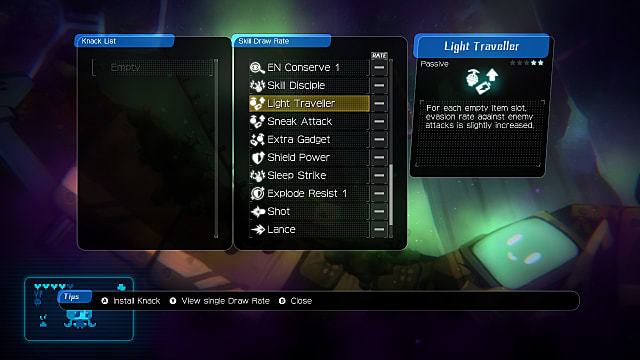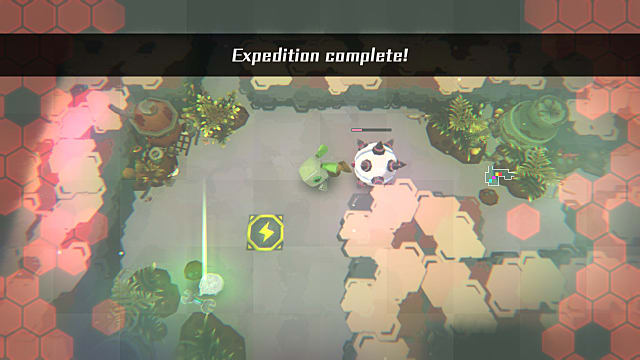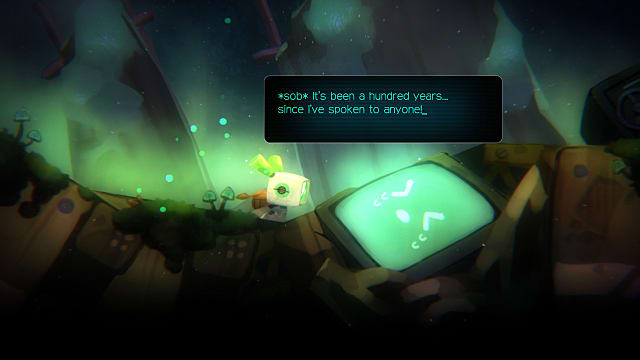

Void Terrarium has some tough shoes to fill. It’s a mystery-dungeon-style game that isn't exactly part of the Mystery Dungeon series. As we’ve discussed before, mystery dungeon is an often derivative style relying on the charm of the franchises it blends with more than anything else.
Void Terrarium is the exact opposite. It’s a standalone game with no existing attachments that rises head and shoulders above the competition thanks to some clever design and plenty of sub-systems that keep every dungeon crawl feeling like an adventure.
Void Terrarium Review: The Little 'Bot that Could
Void Terrarium casts you as an initially nameless robot who’s re-activated by chance when a mouse gets involved with its circuits. You’re just as clueless as the completely adorable, dog-like robot trundling along through a short tutorial dungeon. Eventually, you happen upon a busted vase and a computer screen. That computer screen, Factory AI. is your sole companion in Void Terrarium, and it tells you some of its story, the backdrop for why you’re doing what you're doing.
Like most games in its style, Void Terrarium is relatively light on story compared to gameplay. But what you do get is pretty endearing thanks to how it unfolds. Outside the broader picture, your story is gradually finding a way to make a life for Toriko, a girl you come across, possible, and, hopefully, better.
That overriding goal adds meaning to the countless dungeon crawls you’ll send Robbie (the 'bot) on. While some sub-goals are more urgent and engaging than others — creating a contamination serum versus building a bed frame — everything you do is still directly tied to that primary purpose.
The end goal and the numerous sub-systems surrounding it keep these treks from feeling like slogs and make Void Terrarium one of the few mystery-dungeon style games that doesn’t get old very, very quickly.
Of course, there are the usual things like Robbie’s energy (EN), which is sort of like the hunger meter from Pokémon Mystery Dungeon, only much more important. But after your first few treks, there’s something else as well: the Pet Nanny, or Penny, as FactoryAI calls it. Penny is Robbie’s Tamagotchi Pet, and that’s meant literally.
It shows chibi-Toriki’s condition, hunger meter, how many piles of Toriko droppings she’s left lying around, and later, other things like the weather conditions (which affects enemy stats) and Toriko’s contamination rate. Pet Nanny ends up dictating most of what you do, like caring for a real pet. If the terrarium is too dirty, Toriko suffers.
If her hunger meter depletes, well, there’s no mystery what happens there. And if the contamination rate is too high, she enters a state of toxicity. Aside from keeping her alive as part of the game, you just naturally want to take care of Toriko anyway because she's a human who's alone and in need.
There’s a bit of humorous irony in a human-less future where robots play caretaker for a pet human, though it is just a touch awkward at first. However, it also works exceptionally well for framing your choices.
You’ll get primary goals, like building the terrarium and getting materials to furnish it. Completing these means going into one or more of the many abandoned underground areas to find specific materials on a certain level or held by a certain enemy creature. Fortunately, there’s a hint option on the area select screen that tells you what floor or enemy to look for, which makes these main quests so much smoother.
While you’re doing all this, though, you need to keep an eye on the Pet Nanny. If Toriko is hungry and the vault with your food supplies is running low, you should prioritize finding biological materials you can feed to her. If the terrarium fills up with poo, which it does the longer you’re away, you’ll either need to end the trek early to go clean or spend Energy to clean it remotely.
Finding food for Toriko is good, but if the contamination rate is too high, you’ll need to either find something else or hope you find a Decontamination Kit to make it safe. These are just some of the choices you’ll have to make on the fly.
When you get back, you’ll need to craft the required item from what you found and from more general materials. You get a handy first-time bonus for crafting things. These range from giving Toriko a boost to augmenting Robbie’s abilities in some form, such as improving HP or expanding inventory. This is also one of just a few ways you’ll improve Robbie’s functions (more on that in a bit), so it’s worth crafting everything on the list.
Aside from key items you find for crafting, you need a set number of other materials in four different categories. The leftover items you pick up during a dungeon crawl get recycled and added to each category depending on what the item was. The underground’s AI system detects broken-down items and puts them through the blender, as it were. The upgrades Robbie earns through leveling up in the dungeons are temporary. Once Robbie breaks down (loses all its health), you’re back to square one.
It’s sort of like losing everything in Shiren the Wanderer, but without actually chipping away at your sanity. “Losing” in Void Terrarium isn’t really losing. You “complete” your expedition and always have something to show for it, whether that’s more materials to put towards future crafting, food, or the critical item you needed to move forward. It’s an encouraging and addictive cycle with plenty of incentive to try again.
Part of that incentive also stems from the randomness that rules Void Terrarium.

Robbie earns new passive and (sometimes) active skills upon leveling up, but these are random. Once in awhile, you’ll get lucky and turn Robbie into a powerhouse tank with regular increases to attack and defense. Other times, you’ll get new skills to help out in combat. And sometimes, you’ll get a lackluster set with upgrades that don’t really fit together, like trap-finding and strength boosts based on inventory levels.
Items are random as well. Some visits give you plenty of necessary tools like batteries to restore EN and tool kits to refill health. Some are loaded with items you can recycle for more materials. Others just seem barren in general, so it turns into a test to see how far down you can make it.
It’s initially frustrating, until you get in a groove of regular visits to each dungeon. That’s when Void Terrarium’s practice of always rewarding you in some way, like with new materials, shines through the most. It can turn into a grind, especially since it takes too long to stock up each material category, but even dungeons where you draw the short straw don’t feel like a waste.
Not that the randomness doesn’t still work against Void Terrarium on occasion. When enemies start using their skills more often in later dungeons, you keenly feel the lack of equippable mods and permanent upgrades that offer Robbie protection against status elements.
There are times when a room’s exit happens to be in a monster room as well, which basically means you won’t be making it out alive. And some dungeon trips do end up frustrating because if you could have improved Robbie’s defense a bit more, then you know you could have made it further and finished your task.

But Void Terrarium offers a few helpful surprises to counterbalance these issues. Not too far into the game, FactoryAI upgrades Robbie with part slots, which, by proxy, give you the chance to increase the draw rates of certain skill types.
So you get the best of both worlds: a tough mystery dungeon-style game (because make no mistake — even with the right upgrades, Void Terrarium is still challenging) and one that’s accessible to all skill levels by rewarding every effort instead of punishing you.
But if all the dungeon crawling gets too much and you want a break, you can decorate Toriko’s terrarium. There’s a nifty placement system that uses four layers of background and foreground to give you more room for items, and it affects how each item looks. It’s disappointing Toriko doesn’t actually use these items — even with a bed, she still sleeps on the ground — but I still spent a lot of time tinkering with it to make the terrarium as cozy and pleasant as possible.
There's not much to note about the actual dungeon design, though sterile dungeons are more a problem with the genre than Void Terrarium in particular. The soundtrack is something I actually stopped noticing after a while, but that's a boon even if it sounds like a backhanded compliment. It's so fitting for each area, it ends up just blending in and creating the atmosphere more than the actual dungeon design.
Void Terrarium Review: The Bottom Line
Pros
- Addictive and rewarding gameplay loop
- Plenty of systems demanding your attention and keeping things fresh
- Engaging story to tie all those systems together
- Unique approach to progression using randomness
- Protec Toriko
Cons
- That unique approach sometimes gets a bit frustrating
- A bit grind-y at times
Void Terrarium is special for how it balances challenge and accessibility to create its own unique identity, a balancing act many other games struggle with. If you're new to the genre, it's a great place to start.
If you're familiar with it, there's plenty of challenge to keep you hooked even outside the story. The randomness and grind might be off-putting for some, but if you're willing to overlook that, Void Terrarium stands as one of the best mystery dungeon games out there.
[Note: A digital copy of Void Terrarium was provided by NIS America for the purpose of this review.]




0 comments:
Post a Comment